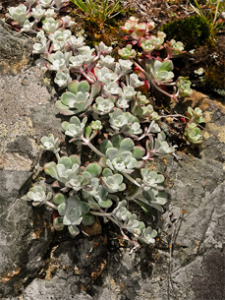 The broadleaf stonecrop, known by the scientific name sedum spathulifolium and the synonyms cotyledon anomala, gormania anomala, sedum anomalum and sedum woodii, is a plant within the crassulaceae family and sedoideae subfamily, sedeae tribe and sedum genus that grows locally. It is sometimes referred to as the Colorado stonecrop, the Pacific stonecrop or the spatula-leaved stonecrop.
The broadleaf stonecrop, known by the scientific name sedum spathulifolium and the synonyms cotyledon anomala, gormania anomala, sedum anomalum and sedum woodii, is a plant within the crassulaceae family and sedoideae subfamily, sedeae tribe and sedum genus that grows locally. It is sometimes referred to as the Colorado stonecrop, the Pacific stonecrop or the spatula-leaved stonecrop.
A dicot, sedum spathulifolium is a perennial herb that is native to California and is also found outside of the Golden State, but is confined to western North America. A flowering plant in the stonecrop family, it can be found in many types of rocky habitat in coastal and inland hills and mountains.
A quite variable succulent plant divided into at least two subtaxa, it is up to 4 inches tall, producing mats of basal rosettes from a system of rhizomes. The sedum spathulifolium has basal leaves up to 0.8 inches long, which are sometimes coated in a waxy, powdery-looking exudate. The inflorescence is a short, erect array of many small flowers with yellow petals. The specific epithet “spathulifolium” refers to the spade-shaped leaves.
This plant will thrive in conditions that many other plants find suitable, but survives or even proliferates under and within less hospitable circumstances and areas. In spots where there is likely to be too much sun or too little water for most plants to grow, the Colorado stonecrop holds up. The name of stonecrop given to sedum reflects the observation that the plant needs little or no care and grows from stones.
The spatula-leaved stonecrop is cultivated as an ornamental groundcover. Sedum is easily planted. For shorter varieties, simply laying the plant on the ground will allow it to get started. The plant will send out roots from wherever the stem is touching the ground and root itself. Rooting can be assured by adding a very thin covering of soil over the plant. For taller sedum varieties, by breaking off one of the stems and pushing it into the ground will initiate a new growth as the stem will root. Numerous cultivars have been selected for garden use, of which ‘Cape Blanco’ has gained the Royal Horticultural Society’s Award of Garden Merit.
Appearing from British Columbia to Southern California, it is notable for sprouting from crevices or the edges of rocks and boulders. This succulent plant tolerates light shade and is tough and cold-hardy. While small, the Pacific stonecrop is a powerhouse, with evergreen foliage, wind and drought tolerance, and showy sprays of intense acid-yellow sprays of starry flowers atop short flower stems in May. The plentiful flowers, approximately four to five inches tall, are attractive to pollinating insects, as the blossoms provide insect nectar and pollen. It serves as a host plant for the San Bruno elfin butterfly, upon which the female after mating will deposit eggs.
From www.houzz.com, https://plants.usda.gov, https://worldofsucculents.com, calflora.org and Wikipedia
SBCSentinel
News of note from around the largest county in the lower 48 states.
